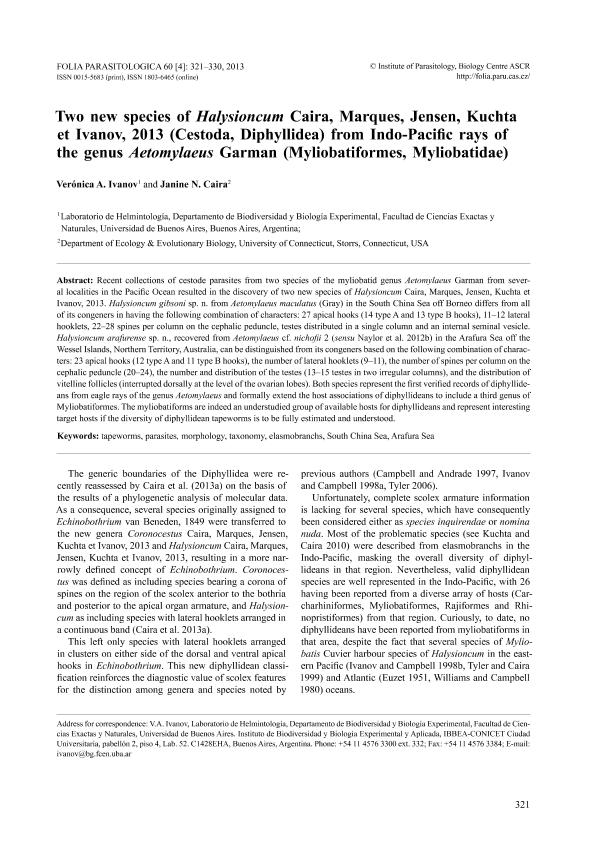Mostrar el registro sencillo del ítem
dc.contributor.author
Ivanov, Veronica Adriana

dc.contributor.author
Caira, Janine N.
dc.date.available
2017-01-17T19:26:31Z
dc.date.issued
2013-08
dc.identifier.citation
Ivanov, Veronica Adriana; Caira, Janine N.; Two new species of Halysioncum Caira, Marques, Jensen, Kuchta et Ivanov, 2013 (Cestoda, Diphyllidea) from Indo-Pacific rays of the genus Aetomylaeus Garman (Myliobatiformes, Myliobatidae); Folia Parasitologica; Folia Parasitologica; 60; 4; 8-2013; 321-330
dc.identifier.issn
0015-5683
dc.identifier.uri
http://hdl.handle.net/11336/11485
dc.description.abstract
Abstract: Recent collections of cestode parasites from two species of the myliobatid genus Aetomylaeus Garman from several localities in the Pacific Ocean resulted in the discovery of two new species of Halysioncum Caira, Marques, Jensen, Kuchta et Ivanov, 2013. Halysioncum gibsoni sp. n. from Aetomylaeus maculatus (Gray) in the South China Sea off Borneo differs from all of its congeners in having the following combination of characters: 27 apical hooks (14 type A and 13 type B hooks), 11?12 lateral hooklets, 22?28 spines per column on the cephalic peduncle, testes distributed in a single column and an internal seminal vesicle. Halysioncum arafurense sp. n., recovered from Aetomylaeus cf. nichofii 2 (sensu Naylor et al. 2012b) in the Arafura Sea off the Wessel Islands, Northern Territory, Australia, can be distinguished from its congeners based on the following combination of characters: 23 apical hooks (12 type A and 11 type B hooks), the number of lateral hooklets (9?11), the number of spines per column on the cephalic peduncle (20?24), the number and distribution of the testes (13?15 testes in two irregular columns), and the distribution of vitelline follicles (interrupted dorsally at the level of the ovarian lobes). Both species represent the first verified records of diphyllideans from eagle rays of the genus Aetomylaeus and formally extend the host associations of diphyllideans to include a third genus of Myliobatiformes. The myliobatiforms are indeed an understudied group of available hosts for diphyllideans and represent interesting target hosts if the diversity of diphyllidean tapeworms is to be fully estimated and understood.
dc.format
application/pdf
dc.language.iso
eng
dc.publisher
Folia Parasitologica

dc.rights
info:eu-repo/semantics/openAccess
dc.rights.uri
https://creativecommons.org/licenses/by-nc-sa/2.5/ar/
dc.subject
Tapeworms
dc.subject
Taxonomy
dc.subject
Morphology
dc.subject
Elasmobranchs
dc.subject.classification
Zoología, Ornitología, Entomología, Etología

dc.subject.classification
Ciencias Biológicas

dc.subject.classification
CIENCIAS NATURALES Y EXACTAS

dc.title
Two new species of Halysioncum Caira, Marques, Jensen, Kuchta et Ivanov, 2013 (Cestoda, Diphyllidea) from Indo-Pacific rays of the genus Aetomylaeus Garman (Myliobatiformes, Myliobatidae)
dc.type
info:eu-repo/semantics/article
dc.type
info:ar-repo/semantics/artículo
dc.type
info:eu-repo/semantics/publishedVersion
dc.date.updated
2016-12-12T21:04:16Z
dc.journal.volume
60
dc.journal.number
4
dc.journal.pagination
321-330
dc.journal.pais
República Checa

dc.description.fil
Fil: Ivanov, Veronica Adriana. Universidad de Buenos Aires. Facultad de Ciencias Exactas y Naturales. Departamento de Biodiversidad y Biología Experimental; Argentina
dc.description.fil
Fil: Caira, Janine N.. University Of Connecticut; Estados Unidos
dc.journal.title
Folia Parasitologica

dc.relation.alternativeid
info:eu-repo/semantics/altIdentifier/url/http://folia.paru.cas.cz/artkey/fol-201304-0003_Two_new_species_of_Halysioncum_Caira_Marques_Jensen_Kuchta_et_Ivanov_2013_Cestoda_Diphyllidea_from_Indo-.php
dc.relation.alternativeid
info:eu-repo/semantics/altIdentifier/doi/http://dx.doi.org/10.14411/fp.2013.033
Archivos asociados
